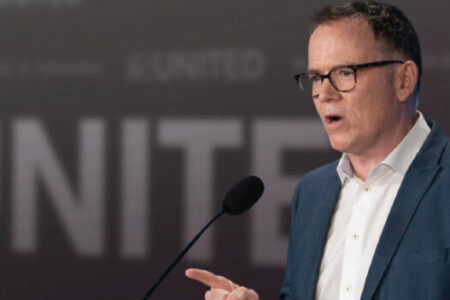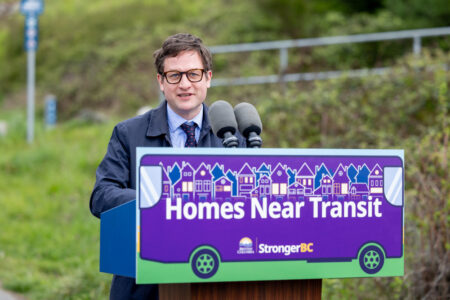Credit union supports regional chamber initiative recommended by Selkirk's innovation chair
An announcement by the Grand Forks District Credit Union (GFCU) was an upbeat ending to a presentation about the state of the economy in the Boundary region. George Penfold, regional innovation chair for Selkirk College, was at Community Futures Boundary last week to give his vision for economic opportunities, along with MLA John Slater and MP Alex Atamanenko. One of his recommendations is now one step closer to reality because of the credit union. The Boundary Communities Regional Chamber of Commerce initiative is the recipient of a grant from the GFCU board in the amount of $30,000 that tops up commitments from the City of Grand Forks and Community Futures Boundary (CFB) of $10,000 each. This seed funding will help the initiative through the first developmental phase. “This regional initiative comes at a crucial time in the Boundary,” noted Michael Strukoff, GFCU board chair. “Our board has been concerned about the economic impact of business closures and changes to the market. Supporting the establishment of the regional chamber initiative is another way for our credit union to directly support our local businesses.” Penfold couldn’t agree more. While his presentation last Thursday, Aug. 26 took the audience through a variety of information and statistics outlining the current state of the economy, demographics, and worldwide trends, he also made some suggestions on how to move forward. Penfold said that the current economic development programs assume growth, and in fact require growth to succeed, but the reality is local governments should look at how they can sustain the area without that growth. “I go back to the fact that more than half the people who work in Grand Forks don’t live in Grand Forks. If we want to move into the future, recognizing that the communities that we’re serving are not contained by municipal boundaries – how do we do that?” asked Penfold. “We’ve got to figure out some more elegant way of consistently thinking about community in a different way than municipal boundary. If you don’t do it, and you continue to divide yourselves as very small communities into identities that have to solve problems that are way beyond maybe the grasp of the larger area in some cases, you’re setting yourself up to fail.” Penfold’s vision? Reorganize how the Boundary is managed by creating two district municipalities, one regional chamber and possibly a regional development corporation to manage development outside of government’s restrictions. Invest in needed and appropriate infrastructure and amenities particularly: 1000 mbps speed internet, energy, housing, transportation, agriculture, training and education, arts and culture and other amenities to attract people. And promote the resulting opportunities to the groups of people most interested in what the region offers. Penfolds said to pursue two groups – active lifestyle migrants to fill vacancies being created by the aging population, and the 55+ age crowd. Slater also agreed that in order for regions to succeed with the current economic trends there needs to be a significant focus on partnerships. “It’s all about partnerships. It can’t be the City of Grand Forks, the regional district, chamber of commerce, it’s got to be everybody getting included in all our partnerships. That’s the only way it’s going to work,” said Slater. “It can’t be a stand-alone economic development or the chamber of commerce or the regional district or municipalities. Count on the federal government and the provincial government to help you out.” Community Futures Boundary was extremely pleased at the donation from the GFCU towards the regional chamber initiative. “I am just delighted with the credit union. They’ve done just a fantastic job of working with us to try and make this happen. Kelly and his board have just been outstanding,” exclaimed Wendy McCulloch, general manager of CFB. To date the regional chamber initiative has received a healthy level of support from small- and medium-size businesses across the region and has collected about 200 surveys indicating support for the project. The regional chamber could be a way for businesses to be able to support each other at a higher level than small chambers, be a key organization in securing government funding and potentially could be the region’s destination marketing organization doing marketing and sales programs for tourism.
For more information about the regional chamber project contact Sarah Winton at Community Futures Boundary – sarah@boundarycf.com. Complete the business survey at www.boundarycf.com and return it to Community Futures Boundary.






















